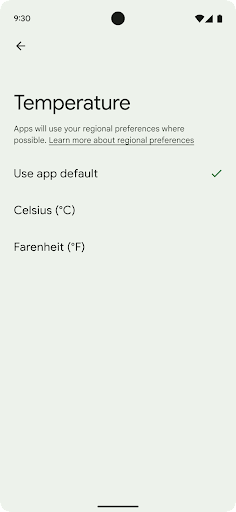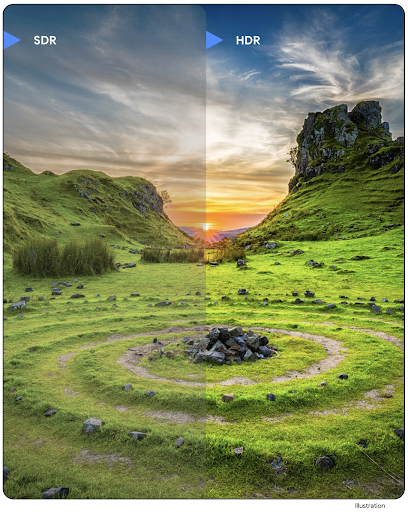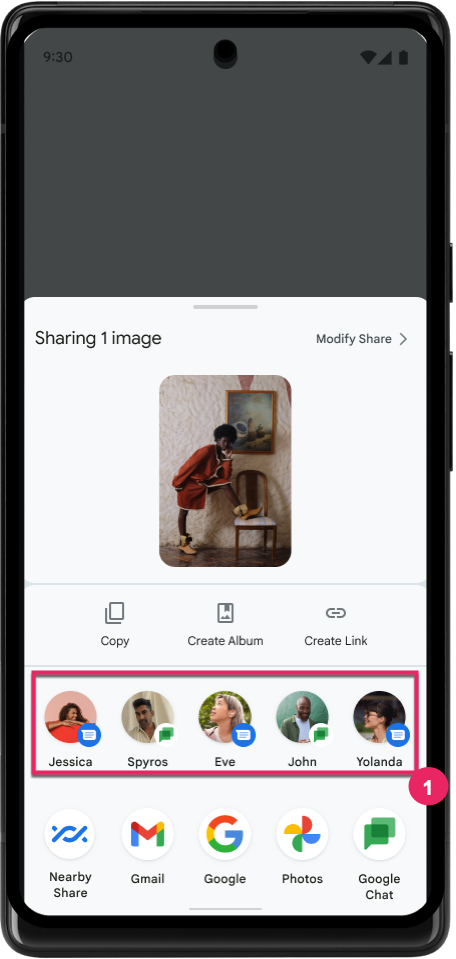Android 14 為開發人員推出了強大的功能和 API。以下各節可協助您瞭解應用程式功能,並開始使用相關的 API。
如需新增、修改及移除 API 的詳細清單,請參閱 API 差異比較表。如要進一步瞭解新增的 API,請參閱 Android API 參考資料。針對 Android 14,請尋找 API 級別 34 中新增的 API。如要瞭解平台變更可能對應用程式造成的影響,請務必查看指定 Android 14 的應用程式和所有應用程式的 Android 14 行為變更。
國際化
個別應用程式語言偏好
Android 14 expands on the per-app language features that were introduced in Android 13 (API level 33) with these additional capabilities:
Automatically generate an app's
localeConfig: Starting with Android Studio Giraffe Canary 7 and AGP 8.1.0-alpha07, you can configure your app to support per-app language preferences automatically. Based on your project resources, the Android Gradle plugin generates theLocaleConfigfile and adds a reference to it in the final manifest file, so you no longer have to create or update the file manually. AGP uses the resources in theresfolders of your app modules and any library module dependencies to determine the locales to include in theLocaleConfigfile.Dynamic updates for an app's
localeConfig: Use thesetOverrideLocaleConfig()andgetOverrideLocaleConfig()methods inLocaleManagerto dynamically update your app's list of supported languages in the device's system settings. Use this flexibility to customize the list of supported languages per region, run A/B experiments, or provide an updated list of locales if your app utilizes server-side pushes for localization.App language visibility for input method editors (IMEs): IMEs can utilize the
getApplicationLocales()method to check the language of the current app and match the IME language to that language.
文法轉變 API
3 billion people speak gendered languages: languages where grammatical categories—such as nouns, verbs, adjectives, and prepositions—inflect according to the gender of people and objects you talk to or about. Traditionally, many gendered languages use masculine grammatical gender as the default or generic gender.
Addressing users in the wrong grammatical gender, such as addressing women in masculine grammatical gender, can negatively impact their performance and attitude. In contrast, a UI with language that correctly reflects the user's grammatical gender can improve user engagement and provide a more personalized and natural-sounding user experience.
為了協助你針對使用文法性別的語言,建構以使用者為中心的使用者介面,Android 14 採用了文法轉變 API,可讓你新增對文法性別的支援,而不必重構應用程式。
地區偏好設定
Regional preferences enable users to personalize temperature units, the first day of the week, and numbering systems. A European living in the United States might prefer temperature units to be in Celsius rather than Fahrenheit and for apps to treat Monday as the beginning of the week instead of the US default of Sunday.
New Android Settings menus for these preferences provide users with a
discoverable and centralized location to change app preferences. These
preferences also persist through backup and restore. Several APIs and
intents—such as
getTemperatureUnit
and
getFirstDayOfWeek—
grant your app read access to user preferences, so your app can adjust how it
displays information. You can also register a
BroadcastReceiver on
ACTION_LOCALE_CHANGED
to handle locale configuration changes when regional preferences change.
To find these settings, open the Settings app and navigate to System > Languages & input > Regional preferences.


無障礙設定
非線性字型縮放至 200%
自 Android 14 起,系統將支援高達 200% 的字型縮放倍數,為使用者提供額外的無障礙選項。
為避免畫面上的大型文字元素縮放過大,系統會套用非線性縮放曲線。套用此縮放策略後,大型文字的縮放比例會和小型文字的縮放比例有所區別。非線性字型縮放有助於在不同大小元素之間維持比例階層,同時減少高度縮放時的線性文字問題 (如:文字遭到截斷,或因為顯示大小過大而導致文字難以辨識)。
使用非線性字型縮放測試應用程式

如果您已使用可縮放像素 (sp) 單位定義文字大小,這些額外選項和縮放功能改善項目就會自動套用至應用程式中的文字。不過,您仍應啟用最大字型大小 (200%) 執行 UI 測試,確保應用程式正確套用字型大小,並在不影響可用性的情況下,因應更大的字型。
如要啟用 200% 的字型大小,請按照下列步驟進行:
- 開啟「設定」應用程式,然後依序前往「無障礙中心」>「顯示大小與文字」。
- 在「字型大小」選項中,輕觸加號 (+) 圖示,直到達字型大小上限為止,如本節隨附的圖片所示。
使用經過調整像素 (sp) 的單位處理文字大小
請記得一律以 sp 單位為單位指定文字大小。如果您的應用程式使用 sp 單位,Android 可套用使用者偏好的文字大小,並適當縮放。
請勿使用 sp 單位做為邊框間距,也不要假設有隱含邊框間距而定義檢視畫面高度:使用非線性字型縮放 sp 維度可能會導致比例失衡,因此 4sp + 20sp 不一定會等於 24sp。
轉換經過調整像素 (sp) 的單位
使用 TypedValue.applyDimension() 將 sp 單位轉換為像素,並使用 TypedValue.deriveDimension() 將像素轉換為 sp。這些方法會自動套用至適當的非線性縮放曲線。
避免使用硬式編碼方程式,使用
Configuration.fontScale 或
DisplayMetrics.scaledDensity。由於字型縮放功能不是線性方式,因此 scaledDensity 欄位不再具備準確性。fontScale 欄位僅供參考,因為字型不再使用單一純量值縮放。
使用 sp 單位設定 lineHeight
請一律使用 sp 單位定義 android:lineHeight,而非 dp,這樣行高就會隨著文字縮放。否則,如果文字是 sp,但 lineHeight 是 dp 或 px,文字就不會縮放,看起來會很擁擠。TextView 會自動修正 lineHeight,保留您預期的比例,但前提是 textSize 和 lineHeight 都以 sp 單位定義。
相機和媒體
圖片的 Ultra HDR

Android 14 新增了對高動態範圍 (HDR) 圖片的支援,可在拍攝相片時保留更多感應器資訊,進而呈現鮮豔的色彩和更強烈的對比。Android 使用 Ultra HDR 格式,可與 JPEG 圖片完全相容,讓應用程式與 HDR 圖片無縫互動,並視需要以標準動態範圍 (SDR) 顯示。
當應用程式選擇為活動視窗使用 HDR UI (透過資訊清單項目或在執行階段呼叫 Window.setColorMode()),架構會自動在 UI 中以 HDR 格式轉譯這些圖片。您也可以在支援的裝置上拍攝壓縮的超高動態範圍靜態圖片。感應器可復原更多顏色,因此後製編輯的彈性更高。與 Ultra HDR 影像相關聯的 Gainmap 可用於使用 OpenGL 或 Vulkan 轉譯這些影像。
在相機擴充功能中縮放、對焦、後視等
Android 14 upgrades and improves camera extensions, allowing apps to handle longer processing times, which enables improved images using compute-intensive algorithms like low-light photography on supported devices. These features give users an even more robust experience when using camera extension capabilities. Examples of these improvements include:
- Dynamic still capture processing latency estimation provides much more
accurate still capture latency estimates based on the current scene and
environment conditions. Call
CameraExtensionSession.getRealtimeStillCaptureLatency()to get aStillCaptureLatencyobject that has two latency estimation methods. ThegetCaptureLatency()method returns the estimated latency betweenonCaptureStartedandonCaptureProcessStarted(), and thegetProcessingLatency()method returns the estimated latency betweenonCaptureProcessStarted()and the final processed frame being available. - Support for capture progress callbacks so that apps can display the current
progress of long-running, still-capture processing operations. You can check
if this feature is available with
CameraExtensionCharacteristics.isCaptureProcessProgressAvailable, and if it is, you implement theonCaptureProcessProgressed()callback, which has the progress (from 0 to 100) passed in as a parameter. Extension specific metadata, such as
CaptureRequest.EXTENSION_STRENGTHfor dialing in the amount of an extension effect, such as the amount of background blur withEXTENSION_BOKEH.Postview Feature for Still Capture in camera extensions, which provides a less-processed image more quickly than the final image. If an extension has increased processing latency, a postview image could be provided as a placeholder to improve UX and switched out later for the final image. You can check if this feature is available with
CameraExtensionCharacteristics.isPostviewAvailable. Then you can pass anOutputConfigurationtoExtensionSessionConfiguration.setPostviewOutputConfiguration.Support for
SurfaceViewallowing for a more optimized and power-efficient preview render path.Support for tap to focus and zoom during extension usage.
感應器內變焦
When REQUEST_AVAILABLE_CAPABILITIES_STREAM_USE_CASE in
CameraCharacteristics contains
SCALER_AVAILABLE_STREAM_USE_CASES_CROPPED_RAW, your app
can use advanced sensor capabilities to give a cropped RAW stream the same
pixels as the full field of view by using a CaptureRequest
with a RAW target that has stream use case set to
CameraMetadata.SCALER_AVAILABLE_STREAM_USE_CASES_CROPPED_RAW.
By implementing the request override controls, the updated camera gives users
zoom control even before other camera controls are ready.
無損 USB 音訊
Android 14 gains support for lossless audio formats for audiophile-level
experiences over USB wired headsets. You can query a USB device for its
preferred mixer attributes, register a listener for changes in preferred mixer
attributes, and configure mixer attributes using the
AudioMixerAttributes class. This class represents the
format, such as channel mask, sample rate, and behavior of the audio mixer. The
class allows for audio to be sent directly, without mixing,
volume adjustment, or processing effects.
開發人員工作效率和工具
Credential Manager
Android 14 adds Credential Manager as a platform API, with additional support back to Android 4.4 (API level 19) devices through a Jetpack Library using Google Play services. Credential Manager aims to make sign-in easier for users with APIs that retrieve and store credentials with user-configured credential providers. Credential Manager supports multiple sign-in methods, including username and password, passkeys, and federated sign-in solutions (such as Sign-in with Google) in a single API.
Passkeys provide many advantages. For example, passkeys are built on industry standards, can work across different operating systems and browser ecosystems, and can be used with both websites and apps.
For more information, see the Credential Manager and passkeys documentation and the blogpost about Credential Manager and passkeys.
Health Connect
Health Connect is an on-device repository for user health and fitness data. It allows users to share data between their favorite apps, with a single place to control what data they want to share with these apps.
On devices running Android versions prior to Android 14, Health Connect is available to download as an app on the Google Play store. Starting with Android 14, Health Connect is part of the platform and receives updates through Google Play system updates without requiring a separate download. With this, Health Connect can be updated frequently, and your apps can rely on Health Connect being available on devices running Android 14 or higher. Users can access Health Connect from the Settings in their device, with privacy controls integrated into the system settings.


Health Connect includes several new features in Android 14, such as exercise routes, allowing users to share a route of their workout which can be visualized on a map. A route is defined as a list of locations saved within a window of time, and your app can insert routes into exercise sessions, tying them together. To ensure that users have complete control over this sensitive data, users must allow sharing individual routes with other apps.
For more information, see the Health Connection documentation and the blogpost on What's new in Android Health.
OpenJDK 17 更新
Android 14 continues the work of refreshing Android's core libraries to align with the features in the latest OpenJDK LTS releases, including both library updates and Java 17 language support for app and platform developers.
The following features and improvements are included:
- Updated approximately 300
java.baseclasses to Java 17 support. - Text Blocks, which introduce multi-line string literals to the Java programming language.
- Pattern Matching for instanceof, which allows an object to
be treated as having a specific type in an
instanceofwithout any additional variables. - Sealed classes, which allow you restrict which classes and interfaces can extend or implement them.
Thanks to Google Play system updates (Project Mainline), over 600 million devices are enabled to receive the latest Android Runtime (ART) updates that include these changes. This is part of our commitment to give apps a more consistent, secure environment across devices, and to deliver new features and capabilities to users independent of platform releases.
Java and OpenJDK are trademarks or registered trademarks of Oracle and/or its affiliates.
應用程式商店改善項目
Android 14 introduces several PackageInstaller APIs that
allow app stores to improve their user experience.
Request install approval before downloading
Installing or updating an app might require user approval.
For example, when an installer making use of the
REQUEST_INSTALL_PACKAGES permission attempts to install a
new app. In prior Android versions, app stores can only request user approval
after APKs are written to the install session and the
session is committed.
Starting with Android 14, the requestUserPreapproval()
method lets installers request user approval before committing the install
session. This improvement lets an app store defer downloading any APKs until
after the installation has been approved by the user. Furthermore, once a user
has approved installation, the app store can download and install the app in the
background without interrupting the user.
Claim responsibility for future updates
The setRequestUpdateOwnership() method allows an installer
to indicate to the system that it intends to be responsible for future updates
to an app it is installing. This capability enables update ownership
enforcement, meaning that only the update owner is permitted
to install automatic updates to the app. Update ownership enforcement helps to
ensure that users receive updates only from the expected app store.
Any other installer, including those making use of the
INSTALL_PACKAGES permission, must receive explicit user
approval in order to install an update. If a user decides to proceed with an
update from another source, update ownership is lost.
Update apps at less-disruptive times
App stores typically want to avoid updating an app that is actively in use because this leads to the app's running processes being killed, which potentially interrupts what the user was doing.
Starting with Android 14, the InstallConstraints API
gives installers a way to ensure that their app updates happen at an opportune
moment. For example, an app store can call the
commitSessionAfterInstallConstraintsAreMet() method to
make sure that an update is only committed when the user is no longer
interacting with the app in question.
Seamlessly install optional splits
With split APKs, features of an app can be delivered in separate APK files,
rather than as a monolithic APK. Split APKs allow app stores to optimize the
delivery of different app components. For example, app stores might optimize
based on the properties of the target device. The
PackageInstaller API has supported splits since its
introduction in API level 22.
In Android 14, the setDontKillApp() method allows an
installer to indicate that the app's running processes shouldn't be killed when
new splits are installed. App stores can use this feature to seamlessly install
new features of an app while the user is using the app.
應用程式中繼資料套件
從 Android 14 開始,Android 套件安裝程式可讓您指定應用程式中繼資料 (例如資料安全性做法),以加入 Google Play 等應用程式商店頁面。
在使用者擷取裝置螢幕畫面時偵測
為建立更標準化的螢幕截圖偵測體驗,Android 14 推出了具隱私保護功能的螢幕截圖偵測 API。此 API 可讓應用程式依個別活動登錄回呼。當使用者在具備瀏覽權限的活動中拍攝螢幕截圖時,系統會叫用這些回呼,並傳送通知給使用者。
使用者體驗
Sharesheet 自訂動作與改善排名
Android 14 updates the system sharesheet to support custom app actions and more informative preview results for users.
Add custom actions
With Android 14, your app can add custom actions to the system sharesheet it invokes.

Improve ranking of Direct Share targets
Android 14 uses more signals from apps to determine the ranking of the direct share targets to provide more helpful results for the user. To provide the most useful signal for ranking, follow the guidance for improving rankings of your Direct Share targets. Communication apps can also report shortcut usage for outgoing and incoming messages.

支援預測返回功能的內建和自訂動畫
Android 13 推出了在開發人員選項背後顯示「預測返回主畫面」動畫的功能。只要使用支援的應用程式,並啟用開發人員選項,當您執行滑動返回的操作時,系統就會顯示動畫,指出返回手勢可讓應用程式結束並返回主畫面。
Android 14 內含多項改善項目,並提供有關預測返回手勢的全新指南:
- 您可以設定
android:enableOnBackInvokedCallback=true,選擇針對個別活動啟用預測返回系統動畫,而非針對整個應用程式。 - 我們新增了系統動畫,以配合 Android 13 的「返回主畫面」動畫。新的系統動畫具有跨活動和跨工作的特色,您只要改用預測返回功能,即可自動取得。
- 我們為底部功能表、側邊功能表和搜尋頁面新增了 Material 元件動畫。
- 我們製作了設計指南,讓您瞭解如何建立自訂的應用程式內動畫和轉場效果。
- 我們新增了 API,支援自訂的應用程式內轉換動畫:
在這個 Android 14 預先發布版本中,所有預測返回相關功能都保留在開發人員選項後方。請參閱開發人員指南,瞭解如何讓應用程式改用預測返回功能,以及如何建立自訂的應用程式內轉場效果。
大螢幕裝置製造商個別應用程式覆寫值
Per-app overrides enable device manufacturers to change the behavior of apps on large screen devices. For example, the FORCE_RESIZE_APP override instructs the system to resize the app to fit display dimensions (avoiding size compatibility mode) even if resizeableActivity="false" is set in the app manifest.
Overrides are intended to improve the user experience on large screens.
New manifest properties enable you to disable some device manufacturer overrides for your app.
大螢幕使用者個別應用程式覆寫值
Per-app overrides change the behavior of apps on large screen devices. For example, the OVERRIDE_MIN_ASPECT_RATIO_LARGE device manufacturer override sets the app aspect ratio to 16:9 regardless of the app's configuration.
Android 14 QPR1 enables users to apply per‑app overrides by means of a new settings menu on large screen devices.
應用程式分享螢幕畫面
App screen sharing enables users to share an app window instead of the entire device screen during screen content recording.
With app screen sharing, the status bar, navigation bar, notifications, and other system UI elements are excluded from the shared display. Only the content of the selected app is shared.
App screen sharing improves productivity and privacy by enabling users to run multiple apps but limit content sharing to a single app.
Pixel 8 Pro 上的 Gboard 智慧回覆功能 (由 LLM 驅動)
On Pixel 8 Pro devices with the December Feature Drop, developers can try out higher-quality smart replies in Gboard powered by on-device Large Language Models (LLMs) running on Google Tensor.
This feature is available as a limited preview for US English in WhatsApp, Line, and KakaoTalk. It requires using a Pixel 8 Pro device with Gboard as your keyboard.
To try it out, first enable the feature in Settings > Developer Options > AiCore Settings > Enable Aicore Persistent.
Next, open a conversation in a supported app to see LLM-powered Smart Reply in Gboard's suggestion strip in response to incoming messages.
圖形
路徑可供查詢及內插
Android's Path API is a powerful and flexible mechanism for
creating and rendering vector graphics, with the ability to stroke or fill a
path, construct a path from line segments or quadratic or cubic curves, perform
boolean operations to get even more complex shapes, or all of these
simultaneously. One limitation is the ability to find out what is actually in a
Path object; the internals of the object are opaque to callers after creation.
To create a Path, you call methods such as
moveTo(), lineTo(), and
cubicTo() to add path segments. But there has been no way to
ask that path what the segments are, so you must retain that information at
creation time.
Starting in Android 14, you can query paths to find out what's inside of them.
First, you need to get a PathIterator object using the
Path.getPathIterator API:
Kotlin
val path = Path().apply { moveTo(1.0f, 1.0f) lineTo(2.0f, 2.0f) close() } val pathIterator = path.pathIterator
Java
Path path = new Path(); path.moveTo(1.0F, 1.0F); path.lineTo(2.0F, 2.0F); path.close(); PathIterator pathIterator = path.getPathIterator();
Next, you can call PathIterator to iterate through the segments
one by one, retrieving all of the necessary data for each segment. This example
uses PathIterator.Segment objects, which packages up the data
for you:
Kotlin
for (segment in pathIterator) { println("segment: ${segment.verb}, ${segment.points}") }
Java
while (pathIterator.hasNext()) { PathIterator.Segment segment = pathIterator.next(); Log.i(LOG_TAG, "segment: " + segment.getVerb() + ", " + segment.getPoints()); }
PathIterator also has a non-allocating version of next() where you can pass
in a buffer to hold the point data.
One of the important use cases of querying Path data is interpolation. For
example, you might want to animate (or morph) between two different paths. To
further simplify that use case, Android 14 also includes the
interpolate() method on Path. Assuming the two paths have
the same internal structure, the interpolate() method creates a new Path
with that interpolated result. This example returns a path whose shape is
halfway (a linear interpolation of .5) between path and otherPath:
Kotlin
val interpolatedResult = Path() if (path.isInterpolatable(otherPath)) { path.interpolate(otherPath, .5f, interpolatedResult) }
Java
Path interpolatedResult = new Path(); if (path.isInterpolatable(otherPath)) { path.interpolate(otherPath, 0.5F, interpolatedResult); }
The Jetpack graphics-path library enables similar APIs for earlier versions of Android as well.
使用頂點和片段著色器的自訂網格
Android has long supported drawing triangle meshes with custom shading, but the input mesh format has been limited to a few predefined attribute combinations. Android 14 adds support for custom meshes, which can be defined as triangles or triangle strips, and can, optionally, be indexed. These meshes are specified with custom attributes, vertex strides, varying, and vertex and fragment shaders written in AGSL.
The vertex shader defines the varyings, such as position and color, while the
fragment shader can optionally define the color for the pixel, typically by
using the varyings created by the vertex shader. If color is provided by the
fragment shader, it is then blended with the current Paint
color using the blend mode selected when
drawing the mesh. Uniforms can be passed
into the fragment and vertex shaders for additional flexibility.
Canvas 的硬體緩衝區算繪器
To assist in using Android's Canvas API to draw with
hardware acceleration into a HardwareBuffer, Android 14
introduces HardwareBufferRenderer. This API is
particularly useful when your use case involves communication with the system
compositor through SurfaceControl for low-latency
drawing.

